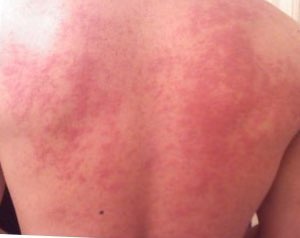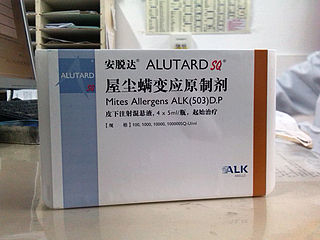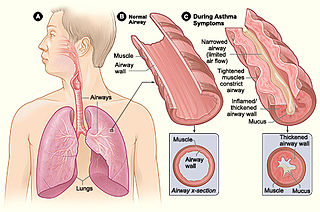Related Research Articles

Allergies, also known as allergic diseases, are various conditions caused by hypersensitivity of the immune system to typically harmless substances in the environment. These diseases include hay fever, food allergies, atopic dermatitis, allergic asthma, and anaphylaxis. Symptoms may include red eyes, an itchy rash, sneezing, coughing, a runny nose, shortness of breath, or swelling. Note that food intolerances and food poisoning are separate conditions.
An allergen is a type of antigen that produces an abnormally vigorous immune response in which the immune system fights off a perceived threat that would otherwise be harmless to the body. Such reactions are called allergies.

A food allergy is an abnormal immune response to food. The symptoms of the allergic reaction may range from mild to severe. They may include itchiness, swelling of the tongue, vomiting, diarrhea, hives, trouble breathing, or low blood pressure. This typically occurs within minutes to several hours of exposure. When the symptoms are severe, it is known as anaphylaxis. A food intolerance and food poisoning are separate conditions, not due to an immune response.

Omalizumab, sold under the brand name Xolair, is an injectable medication to treat severe persistent allergic forms of asthma, nasal polyps, urticaria (hives), and immunoglobulin E-mediated food allergy.

Allergen immunotherapy, also known as desensitization or hypo-sensitization, is a medical treatment for environmental allergies, such as insect bites, and asthma. Immunotherapy involves exposing people to larger and larger amounts of allergens in an attempt to change the immune system's response.
Nambudripad's Allergy Elimination Techniques (NAET) is a form of alternative medicine which proponents claim can treat allergies and related disorders. The techniques were devised by Devi Nambudripad, a California-based chiropractor and acupuncturist, in 1983, drawing on a combination of ideas from applied kinesiology, acupuncture, acupressure, nutritional management, and chiropractic methods.
Health advocacy or health activism encompasses direct service to the individual or family as well as activities that promote health and access to health care in communities and the larger public. Advocates support and promote the rights of the patient in the health care arena, help build capacity to improve community health and enhance health policy initiatives focused on available, safe and quality care. Health advocates are best suited to address the challenge of patient-centered care in our complex healthcare system. The Institute of Medicine (IOM) defines patient-centered care as: Health care that establishes a partnership among practitioners, patients, and their families to ensure that decisions respect patients' wants, needs, and preferences and that patients have the education and support they need to make decisions and participate in their own care. Patient-centered care is also one of the overreaching goals of health advocacy, in addition to safer medical systems, and greater patient involvement in healthcare delivery and design.
Patient advocacy is a process in health care concerned with advocacy for patients, survivors, and caregivers. The patient advocate may be an individual or an organization, concerned with healthcare standards or with one specific group of disorders. The terms patient advocate and patient advocacy can refer both to individual advocates providing services that organizations also provide, and to organizations whose functions extend to individual patients. Some patient advocates are independent and some work for the organizations that are directly responsible for the patient's care.

The Arthritis Foundation is a nonprofit organization addressing the needs of people living with arthritis in the United States.

Food Allergy Research & Education (FARE) is a non-profit, private organization dedicated to food allergy awareness, research, education, and advocacy. FARE's goal is to enhance the lives of people with food allergies by providing support and resources to help them live safe yet productive lives. FARE also includes information for people without food allergies, who are looking to not only be respectful of others but also become more educated and gain more awareness regarding healthcare and treatments. The organization provides information, programs, and resources about food allergies and anaphylaxis, a severe, potentially life-threatening allergic reaction. Working on behalf of more than 32 million Americans who have potentially life-threatening food allergies, FARE's mission is to improve the quality of life and health of those with food allergies and to provide hope for the development of new treatments and diagnostics.
Based in Washington, D.C., Leadership for Healthy Communities is a $10-million national program of the Robert Wood Johnson Foundation designed to engage and support local and state government leaders nationwide in their efforts to advance public policies that support healthier communities and prevent childhood obesity. The program places an emphasis on policies with the greatest potential for increasing sustainable opportunities for physical activity and healthy eating among children at highest risk for obesity, including African-American, Latino, American Indian and Alaska Native, Asian-American and Pacific Islander children living in lower-income communities. The foundation's primary goal is the reversal of the childhood obesity epidemic by 2015.

Asthma is a common pulmonary condition defined by chronic inflammation of respiratory tubes, tightening of respiratory smooth muscle, and episodes of bronchoconstriction. The Centers for Disease Control and Prevention estimate that 1 in 11 children and 1 in 12 adults have asthma in the United States of America. According to the World Health Organization, asthma affects 235 million people worldwide. There are two major categories of asthma: allergic and non-allergic. The focus of this article will be allergic asthma. In both cases, bronchoconstriction is prominent.
Allergy testing can help confirm or rule out allergies and consequently reduce adverse reactions and limit unnecessary avoidance and medications.
Asthma Canada, formerly the Asthma Society of Canada, is a non-profit charity dedicated to enhancing the quality of life and health for people living with asthma and associated allergies. It has a threefold focus on education, research, and advocacy, to continue improving lives for all those with asthma. Asthma Canada represents over 3.8 million Canadians living with asthma, along with their caregivers and all others impacted by asthma, and also provides resources for people suffering from allergies.
The Canadian Lung Association is a national organization and volunteer-based health charity that supports lung health research, education, prevention of disease/disorders and advocacy in Canada.
GA²LEN, or Global Allergy and Asthma European Network, is a consortium of leading European research centres specialized in allergic diseases, which include asthma. Funded by the European Union under the 6th Framework Programme, GA²LEN addresses the growing public health concern of allergic diseases.
The Allergy & Asthma Network, formerly known as Allergy & Asthma Network/ Mothers of Asthmatics (AANMA), is a nonprofit organization in the United States. The Allergy & Asthma Network unites and advocates on behalf of the 60 million Americans with allergies, asthma and related conditions. The Network is tax-exempt, falling under section 501(3)(c) of the United States Internal Revenue Code.

Kari C. Nadeau is the Chair of the Department of Environmental Health at Harvard School of Public Health and John Rock Professor of Climate and Population Studies. She is adjunct professor at Stanford University in the Department of Pediatrics and the co-chair of the Medical Societies Consortium for Climate Change and Health. She practices Allergy, Asthma, Immunology in children and adults. She has published over 400+ papers, many in the field of climate change and health. Her team focuses on quantifying health outcomes of solutions as they pertain climate change mitigation and adaptation at the local, regional, country, and global levels. Dr. Nadeau, with a team of individuals and patients and families, has been able to help major progress and impact in the clinical fields of immunology, infection, asthma, and allergy. Dr. Nadeau is a member of the National Academy of Medicine and the U.S. EPA Children’s Health Protection Committee.
Rice allergy is a type of food allergy. People allergic to rice react to various rice proteins after consuming rice or inhale the steam from cooking rice. Although some reactions might lead to severe health problems, doctors can diagnose rice allergy with many methods and help allergic people to avoid reactions.

Arthur Fernandez Coca was an American immunologist known for his research on allergies.
References
- 1 2 3 "About AAFA". Asthma & Allergy Foundation of America. Retrieved 2024-04-15.
- ↑ "Sources of Financial Support". Asthma & Allergy Foundation of America. Retrieved 2024-04-15.
- ↑ "Regional Chapters". Asthma & Allergy Foundation of America. Retrieved 2024-04-15.
- ↑ "Support Groups". Asthma & Allergy Foundation of America. Retrieved 2024-04-15.